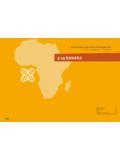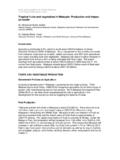Transcription of Country situation and role of agriculture Uganda
1 UgandaCOUNTRY FACT SHEET ON FOOD AND agriculture POLICY TRENDSSEPTEMBER 2015 FAPDA - Food and agriculture Policy Decision AnalysisCountry situation and role of agricultureThe Republic of Uganda , located in Eastern Africa, is a landlocked Country occupying a total area of 241 550 km2, of which 18 percent is open inland waters and wetlands, and percent is arable land. Endowed with significant natural resources, including ample fertile land, regular rainfall and mineral deposits, Ugandan economic growth and development has great potential. Since the Country embarked on liberalization and pro-market policies in the late 1980s, it has witnessed a remarkable improvement in its economic Between 2006/07 and 2012/13, the Government of Uganda (GoU) boosted its investments in infrastructure, yet during the same period, agriculture -specific spending actually declined - barely reaching an average of five This low agricultural investment is lower than the recommendations of the Comprehensive Africa agriculture Development Program (CAADP)
2 Which indicates an allocation of 10 percent of the overall government budget toward agriculture and rural development (as expressed in the Maputo Declaration). In spite of this low government investment, the agricultural sector plays a key role in the nation s economic outlay as it provides employment for over 72 percent of the active population, equally divided between men and indicators2007200920112013 SOCIO-ECONOMICGDP (current billion US$) * per capita (US$) * value added (% of GDP) * value added (annual % growth) *(average 2007-2013) (2013) population (thousand)30 72932 86435 14837 579 Rural population (% of total) labour force (% of total labour force) Development Index **(2013) (ranking 164) agricultural production & TRADEPer capita cultivated land (ha)
3 (2012)Area equipped for irrigation (ha)14 000 (2012)Value of total agriculture production (constant gross value 2004-2006, billion US$)NANANANAV alue of cereals production (constant gross value 2004-2006, billion US$)NANANANAY ield for cereals (hg/ha)15 26020 38320 77621 433 Cereal import dependency ratio (%)(2007-2010) 3 commodities production quantity Plantains; Cassava; Meat indigenous, cattle (2012) production value Plantains; Cassava; Sugar cane (2012)Import quantity Palm oil; Wheat; Sugar refined (2011)Import value Wheat; Palm oil; Sugar refined (2011)Export quantity Coffee, green; Cotton carded, combed; Tea (2011)Export value Coffee, green; Sugar raw centrifugal; Tea (2011)Top 3 trade partners Import valueIndonesia; Kenya; India (2011)Export valueSudan (former); Kenya; Switzerland (2011)FOOD SECURITY & NUTRITIONTop 3 commodities available for consumption (2011)Maize and products; Plantains.
4 Cassava and products (2011)Per capita food supply (kcal/capita/day)225622732279 NAGeneral (g) and Food (f) CPI (2000=100) (g), (f) (g), (f) (g), 289 (f) (g), (f)People undernourished (million) (2008-2010) (2011-2013) of undernourished (%)(2008-2010) (2011-2013)25 Global Hunger Index ^(2013) (serious)Access to improved water sources (% of population) *67707375 (2012)Source: FAOSTAT; *WB; **UNDP; ^ IFPRI (accessed on 6th March, 2015) - Note: Food CPI 2009 and 2012: Index base 2008=1001 During the 1990s and the 2000s, real GDP growth averaged 7 percent per year, the third highest growth rate in Sub-Saharan FAO. 2014.
5 Analysis of public expenditure in support of food and agriculture in Uganda , 2006/07 2012/13. Technical notes series, MAFAP, by Shinyekwa, I., Katunze, M. and Ahmed, M., Rome. Available at Country FACT SHEET ON FOOD AND agriculture POLICY TRENDS | UGANDAThe GoU has made important progress towards meeting the Millennium Development Goals (MDGs). Poverty has decreased significantly in recent years, falling from 31 percent in 2005-06 to 22 percent by 2012-13. However, the Nation s high population growth rate of percent, the fifth fastest growth rate in the world, may be affecting economic progress as Uganda is still considered a very poor The main bottlenecks that have constrained Uganda s development have been underdeveloped human resources, inadequate infrastructure and underdevelopment of Government objectives in agriculture , food and nutrition securityOver the last 25 years, Uganda has made significant development progress.
6 In order to consolidate and accelerate this process, the Poverty Eradication Action Plan (PEAP) was formulated in 1997 to guide the national development policy and public expenditure planning. In 2007 the GoU approved the Comprehensive National Development Planning Framework policy (CNDPF), which outlined the implementation of the 30-year program Uganda Vision 2040 (2013), which is composed of: three 10-year plans, six 5-year National Development Plans (NDPs), Sector Investment Plans (SIPs), Local Government Development Plans (LGDPs), and Annual Work Plans and The strategic objective of the first NDP (2010/2015) and its agriculture sector component, the agriculture Sector Development Strategies and Investment Plan (DSIP), is to restore agricultural growth as an engine to create employment, reduce poverty and increase industrialization.
7 The National Planning Authority is currently outlining the NDP II for 2015-2020, which is expected to inform the budget process of the Financial Year 2015/16. The Ministry of agriculture , Animal Industry and Fisheries (MAAIF) approved in 2013 the National agriculture Policy (NAP) to unify the Country s agriculture approach and guide the future strategies. The overall objective of the NAP is to achieve food and nutrition security and improve household incomes through coordinated sustainable agricultural productivity and value addition, better employment opportunities and promoting domestic and international trade.
8 Aiming at enhancing efficiency, GoU has created seven semi-autonomous institutions under the MAAIF, the most relevant of which are the National agricultural Advisory Services (NAADS), responsible for public agricultural advisory/extension services, and the National agricultural Research Organisation (NARO), which coordinates all national agricultural research activities in Uganda . In order to provide a framework for addressing nutrition issues in the Country , the Government launched the Uganda Nutrition Action Plan 2011-2016, whose ultimate goal is to reduce levels of malnutrition among women of reproductive age, infants, and young Main policy decisions from 2007 to Producer-oriented policy decisionsUganda is putting significant efforts toward addressing the constraints responsible for its low agricultural productivity, which affects farmers incomes and therefore, their food security.
9 The national agriculture strategy is designed to address these constraints though four investment lines: increasing agricultural production and productivity; increasing access to markets and value addition; creating an enabling environment for the private sector in agriculture ; and strengthening agricultural institutions at the centre and in local The biggest developments are being seen in improving the added value of its production , as well as in supporting strategic commodities such as livestock and chain development Value chain development is receiving increasing attention in Uganda as a way of enhancing value added generation in primary sectors.
10 The Country is successfully tapping into a number of value chains, such as rice, sunflowers, cassava, banana, fish, floricultural and horticultural products through the implementation of various projects such as the Support to agro-processing and marketing of agricultural product project (2013-2017), by distributing high quality seeds and machinery, training farmers, enhancing post production infrastructure and improving the market information. Growth prospects in agriculture face a number of constraints due to high production costs, especially for transport and energy. Regarding transport, GoU is heavily investing in expanding and maintaining the road network with special emphasis on roads in agricultural areas.


















